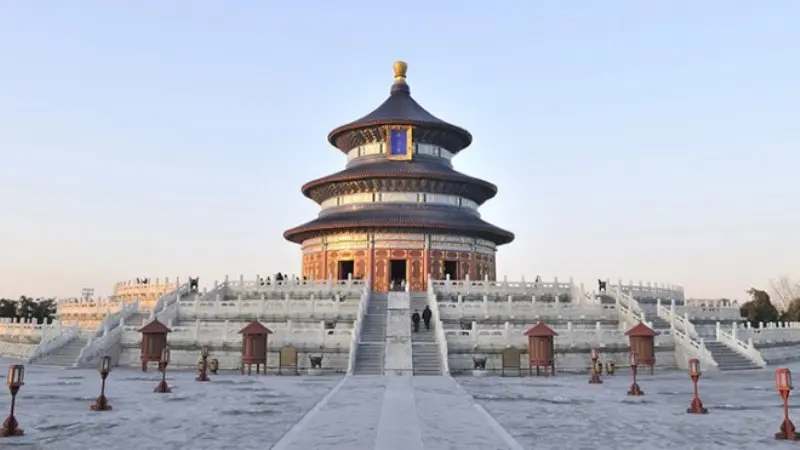History
The Temple of Heaven, located in Beijing, China, is a majestic testament to ancient Chinese architecture and spiritual devotion. Built during the Ming Dynasty in the early 15th century, it served as a sacred space where emperors of the Ming and Qing dynasties performed solemn rituals to communicate with heaven and ensure a prosperous harvest for the empire.
The construction of the Temple of Heaven was initiated by Emperor Yongle, who also commissioned the construction of the Forbidden City. The complex underwent subsequent expansions and renovations, with the most significant additions occurring during the reign of Emperor Qianlong in the 18th century. It was during this time that the complex reached its current architectural splendor.
Today, the Temple of Heaven stands as a UNESCO World Heritage site and one of the most iconic cultural landmarks in China. It is revered for its historical significance, stunning architectural design, and serene atmosphere.
Why Visit
A visit to the Temple of Heaven offers a remarkable opportunity to delve into China’s imperial past, witness exquisite architectural craftsmanship, and experience the spiritual and cultural heritage of the country. Here are some compelling reasons to explore this sacred site:
1. Historical Significance
The Temple of Heaven holds immense historical importance as a symbol of the imperial power and religious beliefs of ancient China. It provides insights into the rituals and ceremonies performed by emperors to ensure the prosperity and well-being of the nation.
2. Architectural Splendor
The architectural design of the Temple of Heaven is a masterpiece of ancient Chinese craftsmanship. From the grand Hall of Prayer for Good Harvests to the intricate details of the surrounding structures and gardens, every element reflects the meticulous attention to detail and the grandiose aesthetic of imperial architecture.
3. Cultural Heritage
Visiting the Temple of Heaven allows you to immerse yourself in the rich cultural heritage of China. Explore the cultural rituals, symbolic meanings, and philosophical beliefs associated with the temple, gaining a deeper understanding of traditional Chinese values and traditions.
4. Serene Atmosphere
The Temple of Heaven is known for its tranquil ambiance, offering a peaceful retreat amidst the bustling city. The expansive gardens, ancient trees, and open courtyards provide a serene environment for relaxation, meditation, and contemplation.
Location and Route
The Temple of Heaven is located in the southeastern part of Beijing, within the Dongcheng District. Getting to the temple is convenient, and various transportation options are available:
- Metro: Beijing’s efficient metro system offers direct access to the Temple of Heaven. The Tiantandongmen Station (Line 5) and the East Gate of Temple of Heaven Station (Line 2) are the nearest metro stations to the temple complex.
- Bus: Numerous bus routes operate in the vicinity of the Temple of Heaven, making it easily accessible from different parts of Beijing. Bus stops are conveniently located near the entrance.
- Taxi: Taxis are readily available throughout the city, and you can easily hail one to reach the Temple of Heaven. Ensure you have the name and address written in Chinese characters to communicate with the driver effectively.
When to Visit
The Temple of Heaven can be visited year-round, but the best time to visit depends on your preferences and the weather conditions. Here are some considerations:
- Spring (April to May) and Autumn (September to October): These seasons offer mild temperatures and pleasant weather, making it comfortable to explore the temple complex. The blooming flowers in spring and the vibrant foliage in autumn add to the charm.
- Summer (June to August): Beijing summers can be hot and humid, so be prepared for high temperatures if you visit during this time. However, summer also brings longer daylight hours, allowing for extended exploration of the temple complex.
- Winter (December to February): Winter in Beijing can be cold, with temperatures dropping below freezing. However, visiting during this time offers the advantage of fewer crowds, providing a more tranquil and immersive experience. The winter landscape, with snow-covered pavilions, can be a sight to behold.
What to See
The Temple of Heaven is an expansive complex with several significant structures and landmarks. Here are some highlights of what to see when visiting:
1. Hall of Prayer for Good Harvests
This magnificent triple-gabled circular building is the main highlight of the Temple of Heaven. Admire its unique architectural design, intricate details, and colorful decorations. This hall was where the emperor prayed for a good harvest and held ceremonies to honor heaven.
2. Echo Wall
Located within the Imperial Vault of Heaven, the Echo Wall is a fascinating acoustic phenomenon. A whisper against the wall can be heard clearly on the opposite side, creating an intriguing experience for visitors.
3. Imperial Vault of Heaven
This circular building houses the iconic Echo Wall and the Imperial Vault of Heaven, a gilded wooden chest that was believed to store tablets representing the gods.
4. Circular Mound Altar
Ascend the three-tiered marble terrace to reach the Circular Mound Altar, where the emperor conducted important sacrificial ceremonies. The layout of the altar symbolizes the circular shape of heaven.
5. Cypress Grove
Explore the tranquil Cypress Grove, filled with ancient cypress trees that are hundreds of years old. These trees add to the serene atmosphere of the temple complex and provide shade and greenery.
6. Divine Music Administration
Located near the east gate, this structure is dedicated to the ritual music performed during ceremonies at the Temple of Heaven. It houses a collection of ancient musical instruments and offers insights into the musical traditions of imperial China.
In conclusion, a visit to the Temple of Heaven is a journey through China’s imperial history, architectural brilliance, and spiritual legacy. It offers an immersive experience into the rituals and beliefs of ancient China, allowing you to appreciate the cultural heritage and philosophical values of the country. Explore its grand halls, stroll through the serene gardens, and let the Temple of Heaven transport you to a bygone era of imperial splendor and spiritual devotion.
